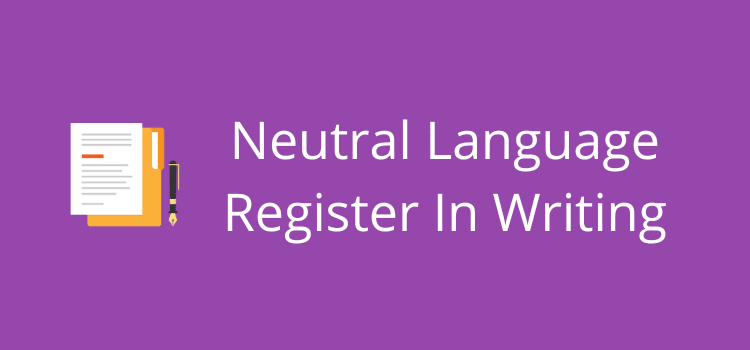Neutral language register, sometimes called objective writing, is a style of writing to present facts.
Its most common use is in scientific or academic texts and also for business and technical writing.
The main characteristics are that it is objective and contains no personal opinion or emotion.
On the register scale, it sits between formal and informal writing and shares some attributes of both.
The key features of neutral register writing
The main register levels in English are determined by the use of variations in grammar, punctuation, and vocabulary.
When writing an objective text, the following seven factors create the neutral tone necessary when presenting facts without emotion or a personal opinion.
1. Third-person point of view – It avoids the pronouns I, you, and we. When pronouns are necessary, the most common is it, and when required, he and she.
2. Other pronouns – Pronouns that are personal, including me, my, us, and our, are not suitable as they are usually used to express a subjective opinion.
3. No contractions – Similar to the formal register, the neutral register uses all words in full.
4. Passive voice – It is very common to use passive sentences as they avoid personal references or opinions.
5. Precise vocabulary – The choice of wording or terminology is specific to the subject or topic to avoid generalities.
6. Objective language – Use vocabulary that is objective and factual. Adjectives and adverbs that intensify, like fantastic, terrific, or wonderfully are often subjective and inappropriate.
7. Shorter sentences – To aid clarity, sentences in neutral writing tend to be shorter and less complex, similar to informal writing.
It is noticeable that the elements above all relate to clarity, purpose, and creating an unbiased and objective tone.
Principal uses for neutral writing
Unlike other styles and registers, there are limited applications for this style of writing.
The most common uses are for the following classifications of texts.
1. Technical manuals – These types of texts state facts or instructions in a concise and clear form.
2. Business reports – Reports usually document results over a fixed period, such as a financial year. But they can also present forecasts for a future period.
3. Research papers – Most often detailing scientific research with citations, findings, and conclusions.
4. Medical articles – Similar to research papers, these present findings, and results of medical studies or clinical trials.
5. Legal advice – Documents of a legal nature are always written in a style that pertains to facts without bias.
6. New articles – It is common to read articles in newspapers that only report facts as opposed to expressing opinions.
Whenever there is a need to state facts without entering into personal opinions or beliefs, neutral language register is the appropriate choice of style.
Examples of neutral writing
When writing in this style, it can involve some rewriting of sentences at times to stay within the objective parameters.
The most critical factor is avoiding sentences or phrases that imply an opinion.
Also, be aware of removing any contractions or abbreviations.
One other tip in this style is to use nouns or noun phrases to start a sentence. It can often result in a passive sentence.
However, unlike other styles where the passive is best removed, in this style, it is perfectly acceptable.
Here are some example sentences in formal, informal, and neutral registers to highlight the differences in form.
I’ve found twenty mentions of climate change in the new report. (Informal)
Should you read the new report, you will find twenty mentions of climate change. (Formal)
Twenty mentions of climate change are contained in the new report. (Neutral)
When we checked last year’s financial results, they weren’t really much different from the year before. (Informal)
Our conclusion is that we believe the financial results for last year were similar to the preceding year. (Formal)
The financial results for last year were similar to the preceding year. (Neutral)
What I’d suggest you do if your computer seems slow is to restart it. When I’m having this issue, it always works. (Informal)
If you have performance issues with your computer, restarting it is often the solution. (Formal)
Performance issues with computers are often resolved with a restart. (Neutral)
It is clear from these examples that the neutral form does not include personal pronouns, contractions, or conditions.
However, it often uses the passive form to avoid personal opinions or conclusions.
Quick tips for writing in neutral language register
The easiest way to write in this style is to concentrate on the beginning of each sentence.
Using nouns makes writing neutral sentences much easier. Also, avoid using conditions such as if, when, and but to start sentences.
In other words, get straight to the point and then present the facts, not possibilities or comparisons.
Another tip is to keep sentences relatively short and express only one idea per sentence.
Summary
For regular readers of Just Publishing Advice, the structure, style, and tone of this article are quite different from most other posts.
That is because it is written in a neutral register, which is not the standard for this blog.
Clearly, it is much more impersonal because it has an emphasis on fact rather than opinion or personal experience.
But that is what makes this style unique and useful in specific contexts and applications.
Related reading: How To Write In Formal Register For Essays And Letters
The post Neutral Language Register In Writing To Present Facts appeared first on Just Publishing Advice For Writers and Authors.
Go to Source
Author: Derek Haines
